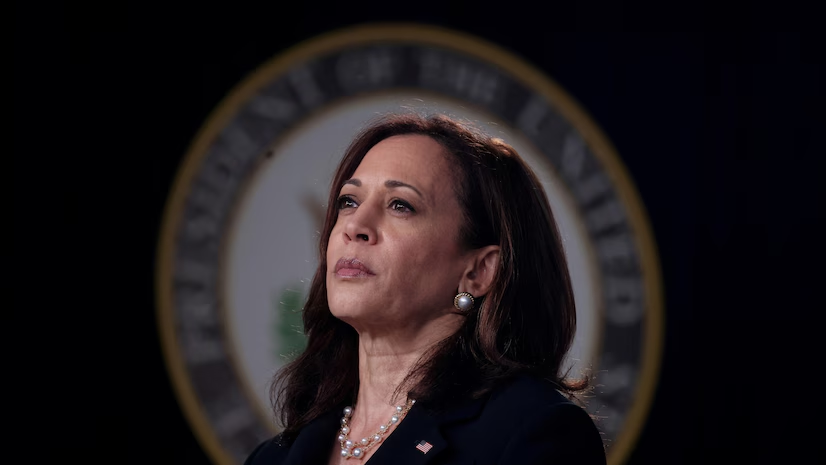AI Policy: As artificial intelligence (AI) becomes a key issue in the 2024 presidential election, the stark contrast between Donald Trump’s and Kamala Harris’s approaches reveals much about their broader visions for technology and innovation. Here’s a detailed look at how Trump and Harris differ on AI policy, with a focus on Trump’s emphasis on minimal regulation and innovation-driven leadership.
Key Highlights:
- Trump’s Vision: Advocates for minimal regulation to encourage rapid technological advancement and maintain global leadership in AI.
- Harris’ Approach: Supports stringent regulations to address AI risks, balancing innovation with public safety and ethical considerations.
- Implications for Future Policy: Trump’s policies aim to boost innovation and infrastructure, while Harris’s framework seeks to ensure responsible AI use through robust oversight.
Donald Trump’s AI Policy: A Push for Innovation and Minimal Regulation

1. Repeal and Replace:
- Critique of Biden’s Order: Trump has pledged to repeal President Biden’s executive order on AI, which he criticizes for imposing excessive regulations that could stifle innovation. Trump argues that the order represents “radical leftwing ideas” that hinder technological progress.
- Focus on Free Market: Trump’s policy is rooted in the belief that reducing regulatory burdens will foster a more competitive environment for technological advancement. His platform emphasizes free speech and human flourishing, reflecting a preference for minimal government intervention in AI development.
2. Silicon Valley Support:
- Backing from Tech Leaders: Trump’s approach is supported by key figures in Silicon Valley, including Elon Musk and venture capitalists Marc Andreessen and Ben Horowitz. These tech leaders have expressed concerns about overregulation and its impact on innovation, aligning with Trump’s vision for a more permissive regulatory environment.
- Infrastructure Investment: Trump has also highlighted the need for increased infrastructure, such as expanded electricity capacity, to support AI development. His strategy includes aligning technological progress with national infrastructure goals to maintain the U.S.’s competitive edge.
3. Historical Context and Future Plans:
- Trump’s Record: During his presidency, Trump signed an executive order prioritizing AI research and development. His administration’s focus was on fostering innovation while addressing civil liberties and privacy concerns without imposing heavy-handed regulations.
- Looking Ahead: If re-elected, Trump plans to continue promoting a regulatory environment that encourages rapid technological advancement and infrastructure development. His approach aims to ensure that the U.S. remains at the forefront of global AI technology.
Read this also: Kamala Harris and Democrats Call Trump and Vance ‘Weird’: A Desperate Tactic
Kamala Harris’ AI Policy: A Framework for Regulation and Safety

1. Regulatory Oversight:
- Support for Biden’s Order: Harris supports the executive order signed by Biden, which scrutinizes high-risk AI systems and aims to safeguard against potential abuses. Her approach emphasizes regulating AI to address immediate risks and protect individual rights.
- AI Bill of Rights: Harris has advocated for an “AI Bill of Rights” to address issues such as algorithmic biases and deepfakes. This framework seeks to balance technological innovation with the need to protect public safety and privacy.
2. Engagement with Tech Companies:
- Promoting Responsible AI: Harris has engaged with leading tech companies to promote ethical AI use. Her policy focuses on securing voluntary commitments from industry leaders to adhere to standards that prevent harm and ensure responsible technology development.
- Balancing Act: While Harris acknowledges the potential benefits of AI, she emphasizes the need for regulatory measures to prevent misuse and protect individuals from the negative impacts of the technology.
3. Experience and Background:
- Expertise from Silicon Valley: Harris’s background as California’s Attorney General and her connections with Silicon Valley inform her regulatory approach. Her policy aims to leverage her understanding of technology to create a balanced framework for AI governance.
Read this also: Senate Hearing to Investigate Security Lapses in Donald Trump Assassination Attempt

Conclusion:
The 2024 presidential election presents voters with a clear choice regarding AI policy. Donald Trump’s vision emphasizes minimal regulation and infrastructure investment to drive innovation and maintain global leadership in AI. In contrast, Kamala Harris advocates for robust regulatory measures to ensure responsible AI use while addressing potential risks and protecting public safety. Voters will need to weigh these contrasting approaches to determine which aligns best with their views on the future of technology and innovation. – Source
Up Next

President Trump Delivers First Joint Address to Congress of Second Term: A Vision for “The Renewal of the American Dream”
Washington, D.C. – March 4, 2025 – President Donald Trump returned to…

Has Trump’s Second Term Already Redefined America? A Triumphant First Six Weeks of Bold Achievements
Donald J. Trump stormed back into the White House on January 20,…

Trump Slams Europe Over Spending on Russian Energy vs. Ukraine Defense: A Deep Dive into the Controversy
On March 3, 2025, U.S. President Donald Trump reignited a contentious debate…





[…] Read this also: Trump and Harris: Divergent Visions for AI Policy in the 2024 Election […]